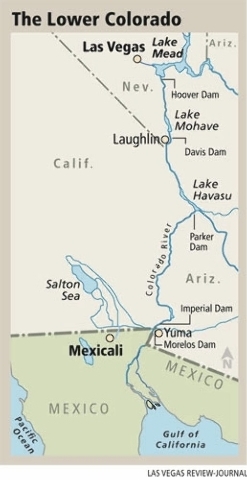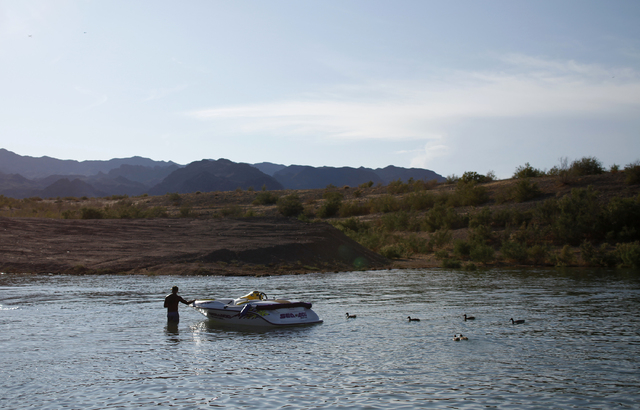New program to pay water users to take less from drought-stricken Colorado River
Farmers, cities and power plant operators could soon be paid to cut their use of the Colorado River under a new interstate program aimed at keeping more water in Lake Mead and Lake Powell.
The four largest communities fed by the Colorado plan to pour millions of dollars into a fund to help farmers and industrial operations pay for efficiency improvements and conservation measures to cut their river water use.
The Colorado River System Conservation Program, as the fund is known, will be seeded with $2 million each from the Southern Nevada Water Authority, Central Arizona Water Conservation District, the Metropolitan Water District of Southern California and Denver Water. Another $3 million will come from the Bureau of Reclamation, the federal agency that oversees the river and many of its dams.
The only direct beneficiary of the pilot program is the river itself, and that’s what makes the effort unique, said Southern Nevada Water Authority general manager John Entsminger.
Water managers have teamed up before to fund conservation measures on the Colorado, but they always did so in exchange for a share of the savings. Any water conserved under this program will be kept in the river.
“That’s why I think this is really different from what has been tried before,” Entsminger said.
His agency and the community it supplies have a keen interest in a healthy Colorado River with full reservoirs. The Las Vegas Valley gets 90 percent of its drinking water from the river by way of two intake pipes in Lake Mead. If the reservoir continues to shrink, water quality will diminish and the shallowest of the two intakes could be forced to shut down.
The water authority board signed off on the conservation concept — and the $2 million — on April 17. Entsminger hopes to see a final agreement among the agencies and the federal government within a month or so. The first conservation projects could be funded as early as this fall, he said.
The money won’t just be used to pay farmers along the river to fallow their fields, Entsminger said, but agriculture will play a major part in the effort because at least 75 percent of all the water diverted from the Colorado irrigates crops.
Farms can cut water use by lining irrigation canals to eliminate leakage and using lasers to level their fields to reduce runoff. Power plants can retrofit their equipment to dramatically reduce the amount of cooling water they need. And the new conservation program can spur such improvements by helping to pay for some of the work, Entsminger said.
Denver Water’s involvement is especially important, he said, because it signals cooperation along the entire length of the river and a recognition that “we’re all in this together.”
“The goal would be to try to get participation from all over the (Colorado River) basin … and even the country of Mexico,” said Entsminger, who said he also hopes to see the pilot program grow and change based on what is learned during its first few years.
The move comes as federal forecasters predict a decline of more than 30 feet in Lake Mead, which is expected to shrink to a new record low this fall and lose more volume after that.
The latest drop got underway early this month, when the surface of the massive reservoir east of Las Vegas slipped below 1,100 feet above sea level for the first time in almost three years.
The Bureau of Reclamation expects Lake Mead to remain below the 1,100-foot mark for the foreseeable future. By November, it is projected to inch down to its lowest level since it was filled for the first time in the late 1930s, surpassing the current record low of just under 1,082 set in November 2010.
A series of new records should follow starting in March, when forecasters expect the lake shed about 13 feet in three months. The decline is expected to bottom out at elevation 1,069 in June of 2015.
Meanwhile Lake Mead’s upstream neighbor will be headed in the opposite direction.
Lake Powell, on the Utah-Arizona border, is expected to rise by about 50 feet over the next 14 months under the complex water-release protocols federal officials use to jointly manage the Colorado River’s two largest reservoirs.
Both lakes have dropped significantly during more than a decade of drought on the over-appropriated river. In terms of water storage, Mead is at about 43 percent of capacity and Powell is at 40 percent.
If the current forecasts come to pass, by June 2015 Powell will increase to 60 percent full while Mead shrinks to an unprecedented low of 35 percent.
Such a drop could cause serious and expensive problems for the National Park Service and its contract marina operators at Lake Mead National Recreation Area. As the water retreats, docks, boat slips and restrooms must be moved, new beaches must be graded, and roads, utility lines and boat launch ramps must be extended.
Spokeswoman Christie Vanover said the Park Service already has a contingency plan in place for maintaining access and shoreline amenities down to a lake level of 1,050 feet above sea level. A new plan is being developed in the unwelcome event that the lake plunges all the way to elevation 950, she said.
“We’re right on the verge of having to extend all of our launch ramps, but we expect to be able to get through this summer,” Vanover said. “It’s important for people to know that no matter what happens there will still be access to Lake Mead.”
Contact Henry Brean at hbrean@reviewjournal.com or 702-383-0350. Find him on Twitter: @RefriedBrean.




















